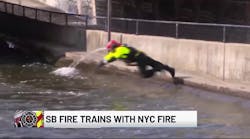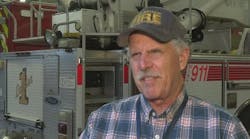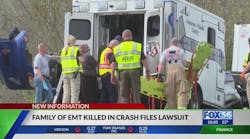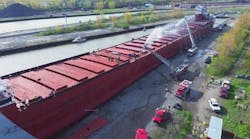We are receiving more and more close calls reports related to fires in single-family dwellings — and it should be no wonder, as that is the most common structural fire fought in North America. When we look at the construction type, which is almost always non-sprinklered lightweight wood truss, the combustibles within today's dwellings, and the issues of training, size-up and staffing, it should be no surprise that close-call and near-miss events have the potential of increasing.
It is critical for all firefighters, fire officers and chiefs to understand that the traditional size-up of your dwelling fire, including a 360-degree walk-around, is only "half" the picture. The other "half" of the picture is the vital importance of understanding that your resources now must match what you have just sized-up. As we have stated before, if your size-up determines that you must establish water, stretch two or three hoselines, force entry, vent, search and perhaps perform rescues, then you must determine what you cannot do if your arrive with one or two companies, each with two or three firefighters.
Simply put, and especially in these horrific budget times with so many firefighters being laid off, companies being shut down or "browned out," it is essential that fire-service leaders make it clear to the elected officials and the public what their fire departments can do and what they may not be able to do, depending on conditions. There can be no arguing that if 30-plus firefighters are needed to perform the above tasks simultaneously, and you have only have five or 10 firefighters on the scene, or delayed companies due to brownouts or layoffs (or both), the required tasks will not be accomplished in the time in which they must be performed.
The math is simple — the clock keeps ticking as the fire grows and we are unable to intervene. Furthermore, that delay or that lack of adequate staffing at the time it is most critically needed will predictably lead to more property loss, more injuries or death to civilians and place firefighters at far greater risk. Keep that in mind the next time you read a story or are personally involved with some of these insane discussions in some city halls related to cutting fire staffing or response times.
While this close call is not 100% directly related to budget cuts, brownouts or reduced staffing (although the Sacramento, CA, Fire Department is going through some very difficult times), it is an excellent example of what can happen at a single-family-dwelling fire. It should be noted that the normally first-due engine on the second alarm was browned out at the time of the alarm and therefore created a delay because other companies had to travel farther.
Compare this close call to your fire department and its training, response, staffing and operational procedures. Consider what would happen if you had companies fail to turnout, in the case of call or volunteer fire departments, or had companies browned out or shut down or members laid off, in the case of career departments. What would your department expect? How would it change your operating procedures? How will cuts reduce the services your department provides to the public? How will the budgetary reductions and related changes reduce the public's ability as well as reduce your ability to survive at a fire? Lots to learn. Lots to think about.
Our sincere thanks to Sacramento Fire Department Chief Ray Jones, Deputy Chief Lloyd Ogan, and the officers and firefighters operating at this fire for their cooperation in providing information so that firefighters all over the world can learn. A special thanks to Fire Captain Rick Hudson (investigations) as well as Fire Captain Jeff Helvin (who was trapped in this fire) for their assistance in the preparation of this column.
This account is by Captain Jeff Helvin, covering officer on Engine 15:
As a department, we learned many things from this fire that almost took the lives of four of our firefighters.
This fire took place on Oct. 7, 2008, in the city of Sacramento. I was the captain of the first-due engine, Engine 15. It took us over six minutes to arrive on scene. I arrived to find a newer two-story wood-frame single-family dwelling (stucco exterior, tile roof, 2,500 square feet, five bedrooms and three bathrooms; very common house on the West Coast) with heavy dark smoke showing from the second floor on the B, A and D sides. I sized-up from sides C, B and A, but did not do a complete 360.
We pulled a 150-foot 1¾-inch pre-connect and forced entry through the front door to find the first floor clear of any smoke from the front of the house to the rear of the house. We advanced the hoseline upstairs and in zero visibility started our search for any victims and the seat of the fire in the rear master bedroom; very thick smoke, but no heat.
After five minutes, my nozzleman stated the "line just went flat." I was searching off the hoseline and slowly made my way back to the hose, thinking it was just a momentary loss of pressure from the engineer going from tank water to hydrant water or charging the backup line. The hose was flat, so I made my way to the hallway to check conditions and that is where I met the extreme change in conditions of intense heat and turbulent smoke.
I made the order to evacuate and got the three firefighters in front of me, as we crawled down a long hallway, to the top of the stairs. This is where we bottlenecked and the first two firefighters tumbled down the stairs and safely made it outside with minor burns. The third firefighter made it halfway down and couldn't stand the heat, so he came back up the stairs and bailed out of a window at the top of the stairway. I felt like the skin was melting off my body, so I turned back down the hallway and retreated to the master bedroom and was going to also bail out of a window. I did two searches for a window that I previously opened during the original search and couldn't find it.
Low on air, like a "turtle" I tucked up in a corner of the room and thought, "This is it, I'm not going to make it out alive" and was in disbelief that I was going to die in this house fire! I thought of my family and the death process I would go through and decided I had to make another attempt down the stairs knowing I would get burned, but I felt like it was my only option. I made it halfway down the stairs and saw fire all around me, so I jumped over the banister handrail, landing in a small living room.
I was very disoriented and at a speed crawled in the direction I landed, which was toward the rear of the house. I looked out of my left peripheral vision when I saw some obscure outside light, which was a sliding glass door that led to the outside. Disoriented, burning and in a panic, I ran through the backyard fence in immense pain and not having any idea if any of the firefighters with me were out and safe.
This account provided by Firefighter Eric Ely, detailed to Engine 15:
On Oct. 7, 2008, Captain Jeff Helvin, Firefighter Bruce Gee, Firefighter Chris Berquist and I nearly lost our lives after becoming trapped upstairs in a dwelling fire. Looking back on the incident, I have never been so terrified in all my life.
I was riding in the nozzle position at the time of the alarm. Upon our arrival, we found light black smoke coming from the A/B and A/D upstairs windows of a single-family dwelling. As we pulled up, I proceeded to stretch a pre-connect line to the front door while Bruce Gee (my backup firefighter) forced the door.
After masking up on the front lawn, I bled the line and checked the pressure/pattern. Immediately after that, I advanced the line into the structure and took a brief second to look at the conditions of the first floor. I quickly made the decision to proceed upstairs, having found no smoke or fire conditions warranting fire on the first floor. At the top of the stairs, the smoke was hazy and cold. Visibility worsened as we pushed down a hall toward the master bedroom on the Charlie side, but still we felt no heat. As I crawled through the smoke, I opened a door to the right and still could not locate the seat of the fire. By this time, my captain had caught up with me with the thermal imaging camera, trying to locate the fire. Suddenly, the conditions in the room began to change rapidly and we were overcome by intense heat seeping through the floor beneath us.
My gut told me that something was incredibly wrong and that the fire was beneath us. Not more than a few seconds later, the hoseline went completely limp. The reason the line went limp is because when the first floor flashed, it literally burned through and destroyed the hoseline.
After notifying the captain of the burst line, I was ordered out of the structure, frantically crawling along the hoseline toward the exit. My captain followed behind me. At the top of the stairs, I heard Bruce and Chris screaming and yelling trying to get out. I heard them fall down the stairs through visible flames. I tried to follow them, but was surrounded by fire that had flashed in the living room below us. I quickly turned back up the stairs and was able to crawl out a window onto the roof of the garage. The Alpha/Delta corner had been laddered and I made my way down.
At that moment, I realized that Captain Helvin had not been accounted for. I asked around frantically, hoping to see him outside with the rest of our brothers. I saw Bruce and Chris groaning in agonizing pain on the front lawn as fellow firefighters stripped their turnouts off of them. I reported to Truck 5 that I had last seen Captain Helvin in the hallway near the window I had exited. Suddenly, a Mayday was transmitted over the radio and Captain Helvin was found almost immediately after on the Charlie side of the structure. A wave of relief came over me when I saw that my captain had made it out of the structure — alive. All four of us were transported with minor to moderate burns.
Many lessons came of this incident and we are all better firefighters having had this experience. I hope that our story prevents this from happening to any other firefighters and that we all continue to train hard and learn from each other's mistakes.
Fire Captain Jeff Helvin will discuss this incident at Firehouse World 2010, Feb. 28-March 4 in San Diego, CA.
WILLIAM GOLDFEDER, EFO, a Firehouse® contributing editor, is a 33-year veteran of the fire service. He is a deputy chief with the Loveland-Symmes Fire Department in Ohio, an ISO Class 2 and CAAS-accredited department. Goldfeder has been a chief officer since 1982, has served on numerous IAFC and NFPA committees, and is a past commissioner with the Commission on Fire Accreditation International. He is a graduate of the Executive Fire Officer Program at the National Fire Academy and is an active writer, speaker and instructor on fire service operational issues. Goldfeder and Gordon Graham host the free and noncommercial firefighter safety and survival website www.FirefighterCloseCalls.com. Goldfeder may be contacted at [email protected].





